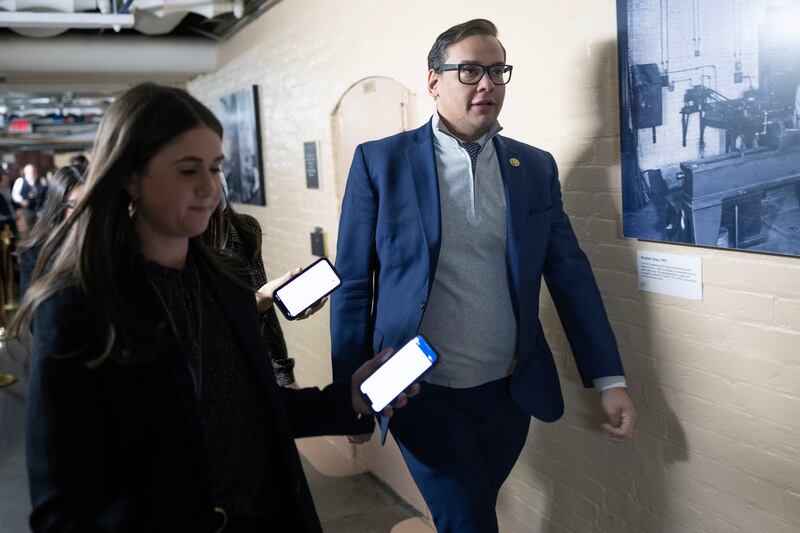There is a scene at the beginning of The Talented Mr Ripley, the 1999 film adaptation of the Patricia Highsmith book, in which Tom Ripley, the young man who becomes one of fiction’s greatest fakers, borrows a Princeton University jacket from a friend to sit in for the piano player at a ritzy garden party. From that assumed finery an entire novel’s worth of cons are born.
It’s not unlike Frank Abagnale shrugging on a PanAm pilot’s uniform in Catch Me If You Can to convince the watching world he is a pilot, or Anna Sorokin, aka Anna Delvey, the fake heiress of recent grift, swanning through New York society in Celine sunglasses and Gucci sandals. Or even Elizabeth Holmes assuming the black turtleneck of Steve Jobs, and with it his mystique.
Throughout history the greatest grifters have understood that dressing the part is half the game. And so it has been with George Santos, the newly elected Republican congressman representing parts of Long Island and Queens, in New York, who has been unmasked as having fabricated pretty much his entire résumé in his quest to get elected, potentially committing campaign-finance fraud in the process.
Why, people keep asking, did it take so long for his lies to be revealed? Why did no one think to poke deeper? Why did the people who did know something fishy was going on not speak up?
In part because he just looked so darn convincing.
He went to the private Horace Mann School and then Baruch College and New York University, and came from money? Behold, the uniform of preppy private schoolboys everywhere: the button-up white shirt, crew-neck sweater (most often in the old-school colors of periwinkle and gray), blue blazer and khaki trousers, like something straight out of Dead Poets Society.
He was a financier who had worked at Citigroup and Goldman Sachs? Lo, the three-quarter zip sweater and fleece (or fleece-like) vest, uniform of bankers everywhere. Just consider the last six seasons of Billions.
He went deep into the costume department of the popular culture hive mind and built his cover story layer by layer, garment by garment.
He may wear suits sometimes, but it is the sweaters, in their various permutations, that have been the telling detail, along with the horn-rimmed glasses — visual shorthand, in pretty much every medium, for intellectual. Both are props that push the buttons of stereotype buried in our subconscious. We are so much more likely to believe a story if it is embedded in the codes we expect, dress code being among the first.

Yes, it’s a cliche. That doesn’t mean it isn’t effective. Clothes are the camouflage that gets you in the door. Especially in a world in which the line between visual truth and fiction is increasingly filtered.
It would not be surprising, then, that Santos is alleged to have bought hundreds of dollars worth of garments and shoes in Brazil using cheques stolen from his mother’s handbag. And that a former room-mate claimed in the New York Post newspaper that the Burberry scarf Santos wore to a Stop the Steal rally in 2021 actually belonged not to him but to the roommate, and that Santos took it when the two men shared an apartment. That another said Santos had taken some of his dress shirts, including an Armani number. Santos clearly understood that, no matter the character you are playing, what you wear tells the story.
So he dressed up his story of embodying the American dream in the fashion vernacular of archetypes. By indulging public preconceptions of how someone with his résumé should look, Santos was implicitly underscoring his own credibility.

And he is still doing it. It is not an accident that since his fabrications have been revealed he has stuck largely to his preppy layering. See the periwinkle-blue crew neck he wore over a white shirt and navy-and-white tie and under a navy suit during his swearing-in: it’s a uniform both protective and promising. One that had a Pavlovian association with words like “wholesome”, “polite”, “youthful”, “well intentioned”. It’s the kind of style that conjures up images of grandmothers saying, “But he looks like such a nice boy.” (He even arrived for the ceremony toting a backpack.)
But in fact, while bankers may love a logo fleece, it’s usually one that advertises the institutions to which they belong or the invitation-only conferences that they attend (Sun Valley! Davos!). Santos’s version, worn mostly on the campaign trail as he was selling his myth, advertised his own candidacy.
And according to Lisa Birnbach, the author of The Official Preppy Handbook, Santos’s version of preppy style is too groomed, too layered, too contrived to be that of a genuine prepster. She says she hasn’t seen a crew neck under a blazer over a tie since George Plimpton ran the Paris Review in the second half of the 20th century. Santos, she said, looks like an extra in Family Ties, the sitcom that starred Michael J Fox as a teenage Republican. He’s trying too hard.
Some are now beginning to speculate that even the glasses are fakes, donned to complete the picture, that they don’t have the distortions associated with corrective lenses. That we should have realised, really, that they were too easy to see through. — This article originally appeared in The New York Times










